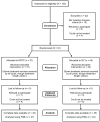Multidimensional treatment foster care for girls in the juvenile justice system: 2-year follow-up of a randomized clinical trial
- PMID: 17295579
- PMCID: PMC1995088
- DOI: 10.1037/0022-006X.75.1.187
Multidimensional treatment foster care for girls in the juvenile justice system: 2-year follow-up of a randomized clinical trial
Abstract
This study is a 2-year follow-up of girls with serious and chronic delinquency who were enrolled in a randomized clinical trial conducted from 1997 to 2002 comparing multidimensional treatment foster care (MTFC) and group care (N = 81). Girls were referred by juvenile court judges and had an average of over 11 criminal referrals when they entered the study. A latent variable analysis of covariance model controlling for initial status demonstrated maintenance of effects for MTFC in preventing delinquency at the 2-year assessment, as measured by days in locked settings, number of criminal referrals, and self-reported delinquency. A latent variable growth model focusing on variance in individual trajectories across the course of the study also demonstrated the efficacy of MTFC. Older girls exhibited less delinquency over time relative to younger girls in both conditions. Implications for gender-sensitive programming for youths referred from juvenile justice are discussed.
Copyright 2007 APA, all rights reserved.
Figures




Similar articles
-
Intervention outcomes for girls referred from juvenile justice: effects on delinquency.J Consult Clin Psychol. 2005 Dec;73(6):1181-5. doi: 10.1037/0022-006X.73.6.1181. J Consult Clin Psychol. 2005. PMID: 16392991 Free PMC article. Clinical Trial.
-
Juvenile justice girls' depressive symptoms and suicidal ideation 9 years after Multidimensional Treatment Foster Care.J Consult Clin Psychol. 2014 Aug;82(4):684-93. doi: 10.1037/a0036521. Epub 2014 Apr 14. J Consult Clin Psychol. 2014. PMID: 24731234 Free PMC article. Clinical Trial.
-
Pregnancy rates among juvenile justice girls in two randomized controlled trials of multidimensional treatment foster care.J Consult Clin Psychol. 2009 Jun;77(3):588-93. doi: 10.1037/a0015289. J Consult Clin Psychol. 2009. PMID: 19485598 Free PMC article.
-
Risks, Outcomes, and Evidence-Based Interventions for Girls in the US Juvenile Justice System.Clin Child Fam Psychol Rev. 2015 Sep;18(3):252-79. doi: 10.1007/s10567-015-0186-6. Clin Child Fam Psychol Rev. 2015. PMID: 26119215 Free PMC article. Review.
-
What Predicts Out-of-Home Placement in Juvenile Court Dispositions? A Systematic Review and Meta-Analysis.J Youth Adolesc. 2023 Jan;52(1):229-244. doi: 10.1007/s10964-022-01686-2. Epub 2022 Oct 19. J Youth Adolesc. 2023. PMID: 36261614
Cited by
-
Promoting healthy outcomes among youth with multiple risks: innovative approaches.Annu Rev Public Health. 2013;34:253-70. doi: 10.1146/annurev-publhealth-031811-124619. Epub 2013 Jan 7. Annu Rev Public Health. 2013. PMID: 23297659 Free PMC article. Review.
-
Bridging the gender gap: interventions with aggressive girls and their parents.Prev Sci. 2010 Sep;11(3):229-38. doi: 10.1007/s11121-009-0167-4. Prev Sci. 2010. PMID: 20107897 Clinical Trial.
-
Percent total attrition: a poor metric for study rigor in hosted intervention designs.Am J Public Health. 2009 Sep;99(9):1567-75. doi: 10.2105/AJPH.2008.134767. Epub 2009 Jul 16. Am J Public Health. 2009. PMID: 19608965 Free PMC article. Review.
-
A Longitudinal Examination of Service Utilization and Trauma Symptoms among Young Women with Prior Foster Care and Juvenile Justice System Involvement.Child Welfare. 2019;97(5-6):199-215. Child Welfare. 2019. PMID: 32308211 Free PMC article.
-
The Oregon Model of Behavior Family Therapy: From Intervention Design to Promoting Large-Scale System Change.Behav Ther. 2016 Nov;47(6):812-837. doi: 10.1016/j.beth.2016.02.002. Epub 2016 Feb 12. Behav Ther. 2016. PMID: 27993335 Free PMC article. Review.
References
-
- Aos S, Phipps P, Barnoski R, Leib R. The comparative costs and benefits of programs to reduce crime (No. 01-05-1201) Washington State Institute for Public Policy; Olympia, WA: 2001. ( www.wa.gov/wsipp)
-
- Aron A, Aron EN. Statistics for psychology. Prentice Hall; Englewood Cliffs, NJ: 1994.
-
- Biesanz JC, Deeb-Sossa N, Papadakis AA, Bollen KA, Curran PJ. The role of coding time in estimating and interpreting growth curve models. Psychological Methods. 2004;9(1):30–52. - PubMed
-
- Capaldi DM, Stoolmiller M. Co-occurrence of conduct problems and depressive symptoms in early adolescent boys: III. Prediction to young-adult adjustment. Development and Psychopathology. 1999;11:59–84. - PubMed
-
- Chamberlain P. Treating chronic juvenile offenders: Advances made through the Oregon Multidimensional Treatment Foster Care model. American Psychological Association; Washington, DC: 2003.
Publication types
MeSH terms
Grants and funding
LinkOut - more resources
Full Text Sources
Medical

